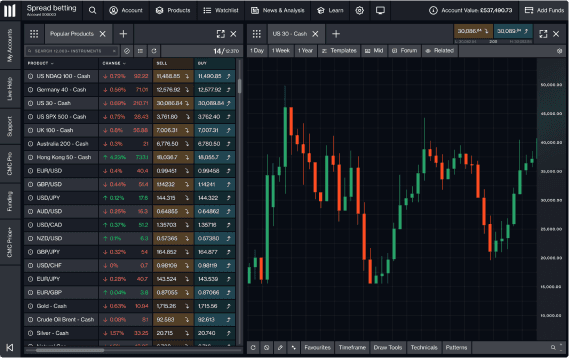Trade with the UK's best CFD trading platform¹
- Trade on 12,000 instruments across forex, shares, indices, commodities, ETFs, treasuries and more
- Enjoy tight spreads and lightning-fast execution², with no hidden fees
Access precise charting and advanced tools


ADVFN International Financial Awards
ForexBrokers.com Awards
Professional Trader Awards
Our CFD trading costs
The two main costs associated with CFD trading are the margin and spread:
Margin – the initial deposit, representing a fraction of the total trade value, which acts as collateral to open positions.
Spread – the difference between the buying and selling price of an instrument.
Trade CFDs on 12,000 instruments. We offer more forex pairs than any other major broker, plus a huge range of indices, commodities, shares, ETFs, rates and bonds, and more. Find all your favourites in one place.Why open a CFD trading account with us?
Get the trade you want – we don't reject or partially fill trades based on size.
Deposit from just 3.34% of the full value of your position to open a trade. Leverage amplifies any profits or losses equally, and can increase the risk of losing money rapidly.
Experience competitive spreads across our full range of instruments, plus low commission fees on shares.
Experience fully automated, lightning-quick execution speeds of 0.0040 seconds.²
What is a CFD trading account?
A CFD trading account allows you to trade contracts for difference (CFDs), enabling you to :
Speculate on the price movements of markets like forex, stocks, and commodities
Trade flexibly on both rising and falling instruments (go long or short)
Seize opportunities across global markets
All without owning the underlying asset.


What do our customers say about trading with us?
How we support our traders
You can contact us whenever the markets are open, from Sunday night to Friday night, when our experienced customer service team will be happy to help.
Our free educational resources cover everything from the stock markets to the intricacies of CFD trading.
Our CFD trading platforms
ForexBrokers.com Awards

Online CFD trading platform
ADVFN International Financial Awards

CFD trading mobile app
Get the functionality of our web platform in your pocket with mobile-optimised charting, full order-ticket features and real-time alerts.
Spread bet or trade CFDs on MT4

MetaTrader 4 (MT4)
Trade on one of the world's most popular platforms, and access our free premium MT4 indicators and Expert Advisors.
FAQs
A contract for difference (CFD) is a derivative product which enables you to trade on the price movements of underlying financial assets (such as forex, indices, commodities, shares and treasuries). It's an agreement to exchange the difference in the value of an asset from the time the contract is opened until the time it's closed.
With a CFD, you never actually own the asset or instrument you're trading, but you can still benefit if the market moves in your favour, or make a loss should the market move against you.
Trading CFDs involves trading on leverage, which means that you can enter a position with a set initial deposit, known as the margin requirement. It's important to remember that leverage amplifies your gains and losses in equal measure, based on the full value of the trade, and not just the initial margin amount. Learn more about CFD trading
The main difference between CFD trading and share trading is that you don't own the underlying share when you trade on a share CFD. With CFDs, you never actually physically buy or sell the underlying asset that you've chosen to trade, but you can still benefit if the market moves in your favour, or make a loss if it moves against you.
With CFDs, you also trade with leverage, which means your initial deposit is smaller, although any profits or losses you make are based on the trade's full value. With traditional share trading, you enter a contract to exchange the legal ownership of the shares for the full value upfront, and you then own this equity.
The main risks associated with CFDs are trading on leverage, which means your profits and losses are amplified based on the full value of your trade, and slippage, or market gapping, which can occur in volatile markets. It's important to manage your risk carefully as part of your overall trading strategy.
As a retail (non-professional) client, your account is protected by negative balance protection, which means that you can't lose more than your account value. Learn about the risks of trading CFDs
Stay on top of breaking economic news events and discover what's moving the financial markets, with commentary from our global market analysts in our news and analysis section.
There's no cost to open a live trading account with us. You can also view prices and use tools such as charts, Reuters news, or Morningstar quantitative research equity reports, free of charge. You'll need to deposit funds in your account to place a trade.
Yes, CMC Markets UK plc (registration number 173730) is fully authorised and regulated by the Financial Conduct Authority (FCA) in the UK. Retail client money is held in segregated client bank accounts and money held on behalf of clients is distributed across a range of major banks, which are regularly assessed against our risk criteria.
Under the FCA's Client Money rules, we're required to segregate client money (unless you agree with us otherwise) from CMC's own funds. The funds held in segregated bank accounts do not belong to CMC, and will be held in a way that enables it to be identified as client money. Learn more about client money regulations
Our income primarily comes from our spreads, while other fees, such as overnight holding costs, also make a contribution to our overall revenue.
Dive deeper

What is CFD trading?
Find out how contracts for difference work and explore the potential benefits.

How to trade CFDs
Learn the basics of CFD trading, from selecting a market to managing your first position.

Advantages and disadvantages of CFD trading
Understand the pros and cons of CFD trading, including flexibility, leverage, and potential risks.


Ready to get started?
Any questions?
Email us at clientmanagement@cmcmarkets.co.uk or call on +44 (0)20 7170 8200.
We're available whenever the markets are open, from Sunday night through to Friday night.